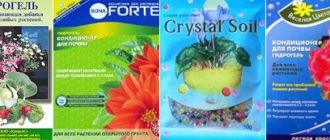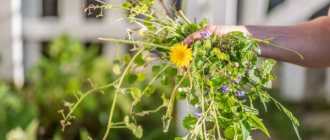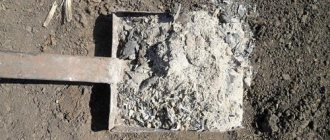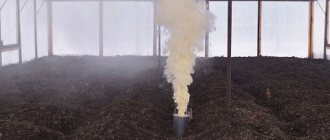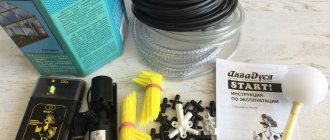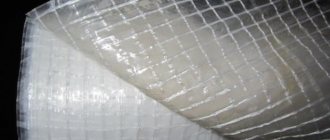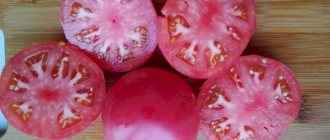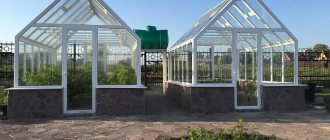How to use hydrogel for plants for indoor and garden plants and growing technology will be described in this article. Science does not stand still, and it has also introduced its innovations into the field of gardening. Scientists have invented a product called hydrogel, which helps retain moisture in plants. In this case, the task of water is entirely aimed at feeding the root system. At the same time, a normal fluid balance is always maintained in the soil.
Some summer residents have already realized the effectiveness of this product and continue to use it. However, there are gardeners who have heard of hydrogel, but know little about it. In this article you will get acquainted with all its properties, characteristics, beneficial qualities and disadvantages, and also learn the technology of growing plants with hydrogel .
Hydrogel for plants: what is it?
From a chemical point of view, a hydrogel is a polymer that can absorb and retain a certain volume of liquid, including nutrient solutions. 1 g of gel can absorb about 0.2-0.3 liters of water. In other words, hydrogel for plants in dry form increases 200-300 times if it is saturated with liquid.
To put the product to work, it should be applied under the plant where the root system is located. Typically, the substance is first soaked in water and then introduced into the soil. If it was sprinkled dry, then the area must be immediately watered abundantly.
Within 15-20 days, the roots will grow through the capsules with the substance and begin to feed on moisture from there. Even if the area has not been watered for a long time and the soil is completely dry, the root system will not be damaged in this case. The plant will not die thanks to the fluid reserves that the hydrogel will provide it with.
The product is very convenient to use if there is a dry summer or summer residents rarely visit their dacha. In addition to water, granules can be filled with liquid fertilizers. Then, with rare care of the plant, it will not only not suffer from lack of water, but will also be fed on time.
The special properties of the hydrogel can maintain normal soil moisture. It collects all the remaining unused water, which the plant will consume as needed.
What are gel beads used for?
Hydrogel for plants will be useful in several cases:
- A very effective way to germinate seeds and root cuttings.
- In this way, nutrients can be delivered to plants easily and over a long period of time.
- Hydroballs retain a significant supply of water, so plants can remain without moisture for a long time.
- The gel acts as a decorative element in decorating flowerpots. They fill a container with indoor plants or freshly cut flowers.
It is important to know that aqua soil for flowers can absorb not only moisture, but also all the nutritional components contained in it. They will have access to the roots of the plant. Therefore, flowers can be easily fed by mixing balls with soil.
Hydrogel and aqua soil - what's the difference?
Do not confuse this hydrogel with a completely different material - Chinese aquasoil, which is also called hydrogel. Despite the fact that they have a similar polymeric nature, their tasks are different. Hydrogel capsules serve as a reservoir for accumulating water, and aqua soil is intended more for decorative purposes.
Manufacturers often produce aqua soil in the form of colored balls. In water they swell and acquire a transparent and beautiful appearance. Sometimes on the market such a product is called an agronomic hydrogel, which has all its advantages. Buyers need to be more careful.
Beautiful granules have only decorative properties. They are not able to help plants. With their help, flower growers create wonderful compositions. You can find many options for such ideas on the Internet or come up with it yourself.
What happens?
This product is presented in the form of a dry powder. Solid crumbs with different shapes absorb water and increase in size by 200-300 times. The result is a mass of jelly-like consistency. Sometimes this material is used as a substrate. However, most often it is applied to the soil, where the roots of the plant penetrate the water-filled granules and take the required amount of moisture.
Liquid hydrogel can also be found on sale. In terms of appearance, it is no different from agricultural hydrogel. However, after adding liquid, the granules do not swell, but dissolve in water. Typically, this substance is used to wet the seeds before planting them in the ground.
This method makes it possible to speed up seed germination. Seeds cannot be germinated directly in liquid hydrogel. The substance envelops them, blocking the access of air. Therefore, seedlings may either die or take a long time to germinate.
Areas of application of hydrogel
The use of agricultural hydrogel is convenient for open (OG) and protected soils (pots, containers, cache-pots and other containers). It is often used in indoor floriculture. Hydrogel is an excellent tool for arranging a lawn and alpine slide. Trees, shrubs, and flower beds are planted using hydrogel.
The effect of preserving water in hydrogel capsules is clearly visible when it is added to containers located on balconies and streets. In these cases, the plants are watered no more than 2 times a week, and the flower arrangements remain beautiful and decorative.
Using hydrogel for growing seedlings.
Hydrogel is used for growing seedlings on an industrial scale. The soil with which the seedling containers are filled dries out quickly, and thanks to the hydrogel, the final loss of moisture occurs much later.
An interesting option is to germinate seeds in a hydrogel, the granules of which swell, providing an excellent moisturizing environment that stimulates the development of sprouts.
Advantages
- Using hydrogel when planting seeds, you can get seedlings 7-14 days earlier. At the same time, the crop yield increases significantly.
- By saturating the granules with liquid fertilizer, the plant will be provided with useful minerals for a long time.
- The soil in which the hydrogel is embedded has a loose structure, so the plant’s root system receives enough oxygen.
- The survival rate of seedlings in such soil is ensured up to 95-98%. Ornamental plants do not lose their original appearance until the end of the season.
- Beneficial from an economic point of view: 0.8-1.6 g of the substance is enough for 1 kg of soil.
How to use hydrogel for plants?
The substance should be added to the soil during its preparation, which must be done before planting the plant in trays, flower beds, etc. At the same time, it is necessary to comply with the standards for applying the substance. For garden and indoor plants growing in containers, add 1 g of dry hydrogel (about ¼ tsp) per 1 liter of soil. Or granules saturated with water are added in the following ratio: 1 tsp. gel for 5 hours of soil. The same set is used for growing seedlings.
Some gardeners use another method: add 1 cup of the swollen substance per 1 liter of soil.
The powdered hydrogel is poured with water and infused for an hour or more. When the granules take up water, the remaining liquid is drained. The gel is mixed with the soil evenly to fill all areas with capsules with reserve moisture.
After the soil has been prepared, seedlings can be planted in it. After 10-14 days, the roots will already penetrate the capsules and the plant will be able to receive enough liquid. Now the area can be watered 2-6 times less, taking into account the temperature and location of the plant.
Under planted plants
There is another method of using technology for growing indoor plants with hydrogel . The substance can be added to trays in which flowers are already growing. To do this, holes are made on the surface of the earth into which dry granules are placed. Water is poured into the holes. If the powder floats, you can sink it to the bottom and sprinkle it with 1-2 cm of earth.
Watch the video! Hydrogel. Features and use of hydrogel
Adding hydrogel to open ground
Upon landing
- When preparing areas for planting plants in open ground, dry hydrogel is used, after which they are thoroughly watered. At the same time, per 1 sq. m. take 25-100 g of granules. First, dig up the soil well, and then add dry matter and mix well.
- For plants whose root system is located close to the surface, dry granules are added to a depth of 10 cm. If the roots of the plant go deep, then the hydrogel is buried into the ground up to 20-25 cm. Then the area is well watered. After the granules are filled with water, the soil in this place rises.
- You can add the hydrogel directly to the hole prepared for planting. In this case, gel and primer are taken in a ratio of 1:5. First, the dry substance is filled with water. After swelling, it is placed at the bottom of the hole and mixed with soil. You can also use the method of layer-by-layer distribution of gel and soil. The roots of the seedling are placed in the hole and covered with soil mixed with gel.
Under planted plants
- The area in the middle of the projection of the crown of a tree or bush is pierced using a suitable tool (stakes, bayonets) to a depth of 15-20 cm. The dry hydrogel is placed at the bottom of the funnels and sprinkled with earth. Now the area needs to be well watered. After 40-50 minutes, it is advisable to water the plant again.
- Another method can be used. First, fill the granules with water. When the hydrogel swells, it must be evenly introduced into the top layer of soil to such a depth as to reach the roots. It is better to carry out this procedure with your hands, since the tool can damage the root system of the plant.
Sowing seeds in hydrogel
It is worth recalling another way to use a polymer substance - germinating seeds using pure hydrogel. Despite the fact that this method is not described in the instructions, many gardeners often use it.
Hydrogel consumption rates:
- For small flowers, dill, parsley, take 20-30 g of the substance in dry form per 1 square meter. The granules are applied to the soil when sowing seeds, after which they should be watered well.
- For radish seeds, 5-10 g of dry hydrogel should be used on 1 linear meter of land. One plant will need 0.2-0.5 g.
- Peas, carrots - 3-5 g of granules are added per 1 linear meter of strip at. For 1 plant – up to 0.3 g.
- For 1 beet bush you need 0.3 g of dry matter.
- For potatoes - up to 2-3 g of hydrogel per area with a radius of 15-20 cm. After this, be sure to water.
- For cucumber, watermelon, zucchini and pumpkin seeds you will need 0.5-1 g of dry matter per 1 square meter. When planting seedlings, 100-150 g of swollen granules are introduced. To prepare the finished gel, you need 10 g of dry matter per 2 liters of liquid.
- To grow tomatoes in a greenhouse, take 0.5-1 g of dry hydrogel or ready-made gel in an amount of 100-150 ml. (10 g of granules per 2 liters of water. Dry hydrogel is added to the bottom of the hole. Plant roots are dipped in the prepared gel and placed in the hole along with the remains of the granules.
- To sow lawn grass you need 50 g of dry matter per 1 square meter.
Before use, the hydrogel is soaked in water. The remaining moisture is drained off, and the resulting mixture is ground until fine. This homogeneous mass is distributed in a layer of 1-2 cm along the bottom of a wide container. Seeds are placed on top, easily pressing them into the gel. After this, the tray is covered with plastic film. When the first leaves appear on the sprouts, it is necessary to plant them in a permanent place along with the gel.
The hydrogel does not need to be thrown away after use. Place it in pots prepared for seedlings. When planting plants in open ground, place the remaining gel in the holes. During watering or rain, the hydrogel granules are replenished with moisture. 1 g of dry substances can absorb up to 200 ml of liquid. Therefore, plants do not need to be watered often.
Seed preparation
After the spring treatment of vegetable or flower seed, you don’t have to dirty your apartment with soil, but use hydrogel for this. You need to pour 4-5 liters of hot water with dissolved nutrients, 2 tablespoons of polymer granules. In this case, you need to be careful: the amount of fertilizer must be reduced by half the usual dose, so as not to damage the delicate roots of the seedlings.
After 2-3 hours have passed, excess moisture must be drained, and the soaked granules should be placed on polyethylene film, dried for an hour, and then placed in seedling boxes. The seeds are placed on hydrogel and slightly moistened. The boxes are transferred to a greenhouse, where the young seedlings will be comfortable.
How to grow indoor bamboo: careful care at home
Read about the use of succinic acid for feeding indoor plants in this article.
Reproduction methods and proper care for dipladeniya at home: https://sazhaem.info/plants/blooming/dipladeniya/uhod-i-razmnozhenie-dipladenii.html
Hydrogel for plants in questions and answers
We will answer the most frequently asked questions about the use of agrotechnical hydrogel for growing crops.
How many years will the hydrogel added to the soil last?
Depending on the active properties of a given soil, the hydrogel can last on average from 3 to 5 years. The substance can withstand the process of freezing and thawing for a long time. Even after complete drying, it does not lose its qualities. When the gel expires, it breaks down into ammonium, carbon dioxide and water.
Is it possible to store the swollen drug?
The finished product can be stored for 1-2 months. To do this, it is placed in a jar and stored in a dark place. Do not forget that the container must be tightly closed with a lid. If it is not closed, the moisture will evaporate and the granules will dry out. There is nothing wrong with this, since before use the substance is filled with water to swell.
How to determine the need to water a plant that has hydrogel in its pot?
When the top layer of soil has dried out and even several centimeters deep, there may still be moisture in the hydrogel. The best way to find out when it's time to water is to monitor the condition of the flower.
With a lack of water, the leaves become limp. You can approximately calculate the interval between waterings. To prevent the plant from wilting, it is recommended to reduce it slightly. You can also use this option. If you water once every 3 days, then after adding capsules to the soil, the watering time can be extended almost 2 times.
Will it increase the humidity around the plant if placed on the surface of the soil in a flower pot?
The hydrogel is not able to retain moisture in the open air, as it quickly evaporates. In this case, the substance cannot perform the functions of air humidification. For these purposes, there is sphagnum moss, which copes with this task perfectly.
